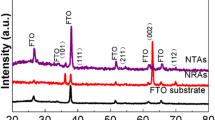Abstract
An Au-coated TiO2 nanotubular array, in the vertically aligned form, was investigated as a highly porous nanostructured electrode for the electrochemical reduction of H2O2 in an acidic sulphate electrolyte at 295 K. The TiO2 nanotubular arrays were formed via a two-stage anodising then nanosized Au particles were sputter deposited onto the surface. The following aspects were studied: (a) the shape evolution of Au particles on the nanotubular array (via surface microstructural imaging), (b) the effect of different degrees of Au loading on the nanotubular array (via voltammetric analysis) and (c) the electrochemical response of an Au–TiO2 nanotubular array compared to a plain, 2-D Au foil. The Au particles could be deposited as a thin 3-D coated layer or as nodular nanostructures on the array. The highly nanoporous structure of the Au–TiO2 electrode led to a large enhancement in the limiting current (enhancement factor up to 6.6) and charge density (enhancement factor up to 8.9) for peroxide reduction compared to a plain Au foil due to the architecture of the ordered, high surface area of the nanotubular array.




Similar content being viewed by others
References
Li Q, Bjerrum NJ (2002) Aluminum as anode for energy storage and conversion: a review. J Power Sour 110:1–10. doi:10.1016/S0378-7753(01)01014-X
Medeiros MG, Bessette RB, Deschenes CM, Patrissi CJ, Carreiro LG, Tucker SP, Atwater DW (2003) Magnesium-solution phase catholyte semi-fuel cell for undersea vehicles. J Power Sour 136:226–231. doi:10.1016/j.jpowsour.2004.03.024
Prater DN, Rusek JJ (2003) Energy density of a methanol/hydrogen-peroxide fuel cell. Appl Energy 74:135–140. doi:10.1016/S0306-2619(02)00139-3
Ponce de Leon C, Walsh FC, Rose A, Lakeman JB, Browning DJ, Reeve RW (2007) A direct borohydride-acid peroxide fuel cell. J Power Sour 164:441–448. doi:10.1016/j.jpowsour.2006.10.069
Ponce de León C, Merino-Jiménez I, Shah AA, Walsh FC (2012) Developments in direct borohydride fuel cells and remaining challenges. J Power Sour 219:339–357. doi:10.1016/j.jpowsour.2012.06.091
Cao D, Gao Y, Wang G, Miao R, Liu Y (2010) A direct NaBH4–H2O2 fuel cell using Ni foam supported Au nanoparticles as electrodes. Int J Hydrogen Energy 35:807–813. doi:10.1016/j.ijhydene.2009.11.026
Ning R, Lu W, Zhang Y, Qin X, Luo Y, Hu J, Asiri AM, Al-Youbi AO, Sun X (2012) A novel strategy to synthesize Au nanoplates and their application for enzymeless H2O2 detection. Electrochim Acta 60:13–16. doi:10.1016/j.electacta.2011.10.066
Sarapuu A, Tammeveski K, Tenno TT, Sammelselg V, Kontturi K, Schiffrin DJ (2001) Electrochemical reduction of oxygen on thin-film Au electrodes in acid solution. Electrochem Commun 3:446–450. doi:10.1016/S1388-2481(01)00198-9
Shin Y, Lee S (2008) Self-organized regular arrays of anodic TiO2 nanotubes. Nano Lett 8:3171–3173. doi:10.1021/nl801422w
Kim JH, Zhu K, Yan Y, Perkins CL, Frank AJ (2010) Microstructure and pseudocapacitive properties of electrodes constructed of oriented NiO–TiO2 nanotube arrays. Nano Lett 10:4099–4104. doi:10.1021/nl102203s
Wang D, Liu L, Zhang F, Tao K, Pippel E, Domen K (2011) Spontaneous phase and morphology transformations of anodized titania nanotubes induced by water at room temperature. Nano Lett 11:3649–3655. doi:10.1021/nl2015262
Mor GK, Shankar K, Paulose M, Varghese OK, Grimes CA (2006) Use of highly-ordered TiO2 nanotube arrays in dye-sensitized solar cells. Nano Lett 6:215–218. doi:10.1021/nl052099j
Ghicov A, Macak JM, Tsuchiya H, Kunze J, Haeublein V, Frey L, Schmuki P (2006) Ion implantation and annealing for an efficient N-doping of TiO2 nanotubes. Nano Lett 6:1080–1082. doi:10.1021/nl0600979
Cao D, Sun L, Wang G, Lv Y, Zhang M (2008) Kinetics of hydrogen peroxide electroreduction on Pd nanoparticles in acidic medium. J Electroanal Chem 621:31–37. doi:10.1016/j.jelechem.2008.04.007
Dilimon VS, Narayanan NSV, Sampath S (2010) Electrochemical reduction of oxygen on gold and boron-doped diamond electrodes in ambient temperature, molten acetamide–urea–ammonium nitrate eutectic melt. Electrochim Acta 55:5930–5937. doi:10.1016/j.electacta.2010.05.047
Kinoshita K (1992) Electrochemical oxygen technology. Wiley, New York
Macak JM, Schmidt-Stein F, Schmuki P (2007) Efficient oxygen reduction on layers of ordered TiO2 nanotubes loaded with Au nanoparticles. Electrochem Commun 9:1783–1787. doi:10.1016/j.elecom.2007.04.002
Inasaki T, Kobayashi S (2009) Particle size effects of gold on the kinetics of the oxygen reduction at chemically prepared Au/C catalysts Original. Electrochim Acta 54:4893–4897. doi:10.1016/j.electacta.2009.02.075
El-Deab MS, Ohsaka T (2002) Hydrodynamic voltammetric studies of the oxygen reduction at gold nanoparticles-electrodeposited gold electrodes. Electrochim Acta 47:4255–4261. doi:10.1016/S0013-4686(02)00487-5
Low CTJ, de la Toba Corral M, Walsh FC (2011) Anodising of titanium in methanesulphonic acid to form titanium dioxide nanotube arrays. Trans Inst Met Finish 89:44–50. doi:10.1179/174591911X12953503084903
Macak JM, Hildebrand H, Marten-Jahns U, Schmuki P (2008) Mechanistic aspects and growth of large diameter self-organized TiO2 nanotubes. J Electroanal Chem 621:254–266. doi:10.1016/j.jelechem.2008.01.005
Mor GK, Varghese OK, Paulose M, Shankar K, Grimes CA (2006) A review on highly ordered, vertically oriented TiO2 nanotube arrays: fabrication, material properties, and solar energy applications. Sol Energy Mater Sol Cell 90:2011–2075. doi:10.1016/j.solmat.2006.04.007
Macak JM, Tsuchiya H, Ghicov A, Yasuda K, Hahn R, Bauer S, Schmuki P (2007) TiO2 nanotubes: self-organized electrochemical formation, properties and applications. Curr Opin Solid State Mater Sci 11:3–18. doi:10.1016/j.cossms.2007.08.004
Low CTJ, Walsh FC (2008) Linear sweep voltammetry of the electrodeposition of copper from a methanesulfonic acid bath containing a perfluorinated cationic surfactant. Surf Coating Technol 202:3050–3057. doi:10.1016/j.surfcoat.2007.11.005
Acknowledgments
Financial support provided by the Research Institute for Industry (RIfI) at Southampton University is gratefully acknowledged.
Author information
Authors and Affiliations
Corresponding author
Rights and permissions
About this article
Cite this article
Low, C.T.J., Ponce de Leon, C. & Walsh, F.C. The reduction of hydrogen peroxide at an Au-coated nanotubular TiO2 array. J Appl Electrochem 44, 169–177 (2014). https://doi.org/10.1007/s10800-013-0623-5
Received:
Accepted:
Published:
Issue Date:
DOI: https://doi.org/10.1007/s10800-013-0623-5




